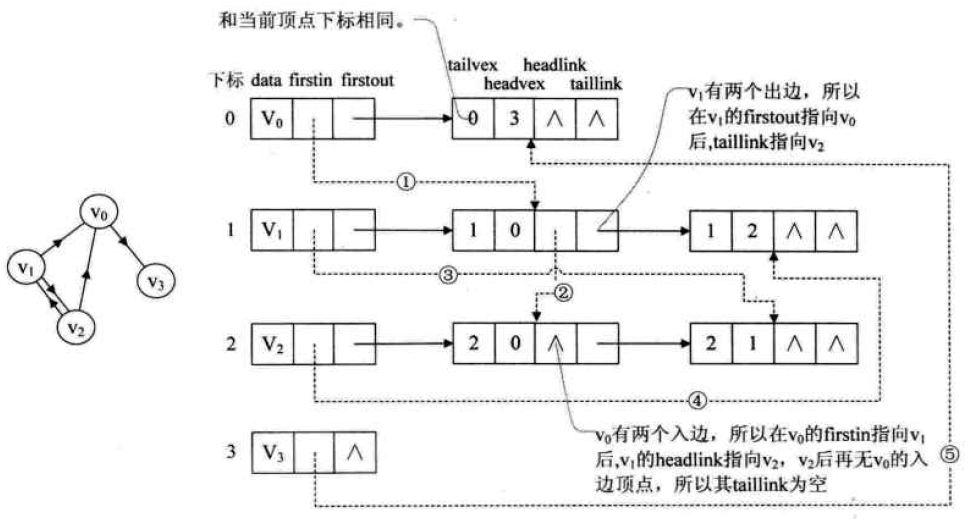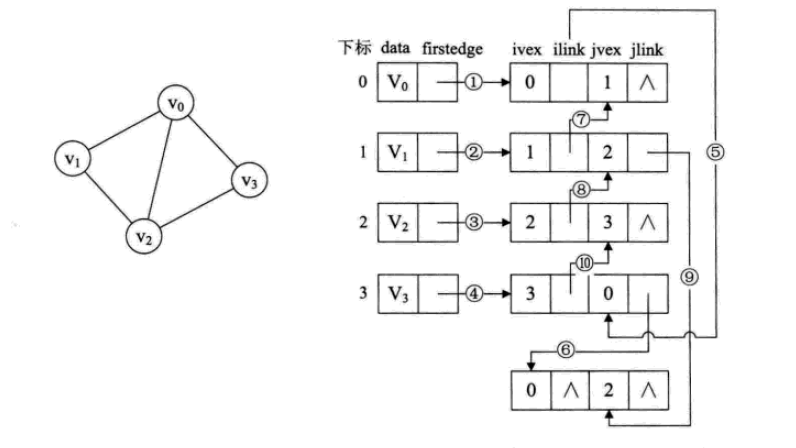一、邻接矩阵:就是一个二维数组
特点:对称(矩阵有对称性),空间代价大(空间需求为O(|v|^2)),适用于稠密图,否则空间浪费较大。

#include<iostream> #include<cstdio> using namespace std; const int maxn = 120; const int INF = 0x3fff; int a[maxn][maxn],n; void Init() { int i,j; for(i=1;i<=n;i++) for(j=1;j<=n;j++) a[i][j]=INF; } void Print() { int i,j; for(i=1;i<=n;i++) { cout<<i<<"的邻接点有:"; for(j=1;j<=n;j++) if(a[i][j]!=INF) cout<<"a["<<i<<"]["<<j<<"]="<<a[i][j]<<" "; cout<<endl; } } int main(void) { int i,j,x,m,y,z; cin>>n>>m; Init(); for(i=0;i<m;i++) { cin>>x>>y>>z; a[x][y]=a[y][x]=z; } Print(); return 0; } /* 测试数据: 5 4 1 2 1 2 3 4 4 5 7 4 3 9 */
二、邻接矩阵:散列表或者多重表

特点:适用于稀疏矩阵,存储空间较小为O(2*|E|)。

#include<stdio.h> #include<stdlib.h> #include<string.h> struct Node{ int data,dis; struct Node *next; }; struct LNode{ struct Node *First; struct LNode *NEXT; }; typedef struct LNode *Lin; int vis[120],m,n; Lin Find(int x,Lin T) { Lin p=T; while(p!=NULL) { if(p->First->data==x) break; p=p->NEXT; } return p; } void Insert(int x,int dis,struct Node* T) { struct Node* tp=T; while(tp->next!=NULL) tp=tp->next; struct Node* p=(struct Node*)malloc(sizeof(struct Node)); p->data=x; p->dis=dis; p->next=tp->next; tp->next=p; //return T; } void dfs(Lin T,int fa,int dis) { if(T==NULL) return ; if(fa) printf("深搜遍历图的一条边:(%d->%d),边的长度为: %d ",fa,T->First->data,dis); fa=T->First->data; for(struct Node* p=T->First->next;p!=NULL;p=p->next) { Lin tp=Find(p->data,T); if(vis[p->data]==0) { vis[p->data]=1; dfs(tp,fa,p->dis); vis[p->data]=0; } } } int main(void) { int i,j,x,y,dis; Lin T,p,tp; T=(Lin)malloc(sizeof(struct LNode)); T->NEXT=NULL; p=T; printf("请输入图的顶点数和边数: "); scanf("%d%d",&n,&m); for(i=1;i<=n;i++) { tp=(Lin)malloc(sizeof(struct LNode)); tp->First=(struct Node*)malloc(sizeof(struct Node)); tp->First->data=i; tp->First->next=NULL; tp->NEXT=p->NEXT; p->NEXT=tp; p=p->NEXT; } printf("请输入图的边: "); for(i=0;i<m;i++) { scanf("%d%d%d",&x,&y,&dis); p=Find(x,T); Insert(y,dis,p->First); p=Find(y,T); Insert(x,dis,p->First); } memset(vis,0,sizeof(vis)); dfs(T->NEXT,0,0); return 0; } /* 测试样例: 5 5 1 2 34 2 3 45 3 4 13 1 4 66 5 1 29 */
三、十字链表(适用于有向图)
1、定义:是一种链式存储结构,可以视为邻接表和逆邻接表的结合,既可以求入度,也可以求出度,十分方便。
解释:
(1)普通的邻接表可以求出入度,普通的逆邻接表可以求出出度,而十字链表可以求出入度+出度。
(2)十字链表对于有向图来说还是非常方便的既可以正向遍历节点,也可以反向进行,类似于双向链表。

2、存储结构:
(1)边节点:每个边界点存储4个变量:tailvex(一条边起点的ID),headvex(一条边终点的ID),taillink(一条边入边的指针),
headlink(一条边出边的指针)。(还可以有存储边的权值的数据)。
(2)点节点:有两个指针:First_IN(表示第一个入度的节点),First_Out(表示第一个出度的节点),data(表示这个节点的编号)。
每个顶点的信息,作为边之间传值的中转站,可以从一条边跑到另一条边。
(3)图结构:VertexNum(点的数量),EdgeNum(边的数量),cur数组(记录图中每个节点的信息)。

#include<iostream> #include<cstdio> #include<cstdlib> using namespace std; const int maxn = 1200; struct EdgeNode{ //边结构体 int tailvex,headvex; struct EdgeNode *taillink,*headlink; }; typedef struct EdgeNode* Edge; struct VertexNode{ //点结构体 int data; Edge First_IN,First_OUT; }; typedef struct VertexNode* Vertex; struct GraphNode{ //图的总结构 int VertexNum,EdgeNum; struct VertexNode cur[maxn]; }; typedef struct GraphNode* Graph; void Create_Graph(Graph &G) //构造一个图 { int i,x,y,z; G=(Graph)malloc(sizeof(struct GraphNode)); scanf("%d%d",&G->VertexNum,&G->EdgeNum); for(i=1;i<=G->VertexNum;i++) { G->cur[i].data=i; G->cur[i].First_IN=NULL; G->cur[i].First_OUT=NULL; } for(i=1;i<=G->EdgeNum;i++) { scanf("%d%d%d",&x,&y,&z); Edge e=(Edge)malloc(sizeof(struct EdgeNode)); e->tailvex=x; //out是出度 ,构建邻接表 e->taillink=G->cur[x].First_OUT; G->cur[x].First_OUT=e; e->headvex=y; //in是入度,构建逆邻接表 e->headlink=G->cur[y].First_IN; G->cur[y].First_IN=e; } } void Show(Graph G) //展示图的入度和出度。 { int i,num; Edge e; for(i=1;i<=G->VertexNum;i++) { printf("%d节点的:",G->cur[i].data); num=0; e=G->cur[i].First_IN; while(e!=NULL) { num++; e=e->headlink; } printf("入度是:%d ",num); num=0; e=G->cur[i].First_OUT; while(e!=NULL) { num++; e=e->taillink; } printf("出度是:%d ",num); } } int main(void) { Graph G; Create_Graph(G); Show(G); return 0; } /* 测试数据: 5 4 1 2 3 2 3 2 3 4 1 4 5 5 */
四、邻接多重表
参考文章:http://www.cnblogs.com/Trojan00/p/8964609.html
思路:邻接多重表主要用于存储无向图,每条边的边界点分别在以该边所依附的两个顶点为头结点的链表中,对于已经找到过的边要做标记。

代码:

#include<iostream> #include<cstdio> #include<cstdlib> using namespace std; const int maxn = 1200; int vis[maxn]={0}; struct EdgeNode{ //图的边结构 int weight,mark; int ivec,jvex; struct EdgeNode *ilink,*jlink; }; typedef struct EdgeNode* Edge; struct VertexNode{ //图的点结构 int id; Edge Firstarc; }; typedef struct VertexNode* Vertex; struct GraphNode{ //图的结构 VertexNode cur[maxn]; int VertexNum,EdgeNum; }; typedef struct GraphNode *Graph; int Locate(Graph G,int pos) { for(int i=1;i<=G->VertexNum;i++) if(G->cur[i].id==pos) return i; return -1; } Graph Create() { int i,x,y,z; Graph G=(Graph)malloc(sizeof(struct GraphNode)); cout<<"请输入图的节点数目和边的数目:"<<endl; cin>>G->VertexNum>>G->EdgeNum; for(i=1;i<=G->VertexNum;i++) //初始化图的每一个节点 { G->cur[i].id=i; //G->cur[i].Firstarc=(Edge)malloc(sizeof(struct EdgeNode)); G->cur[i].Firstarc=NULL; } for(i=1;i<=G->EdgeNum;i++) { cin>>x>>y>>z; int t1=Locate(G,x); int t2=Locate(G,y); if(t1<0||t2<0) printf("ERROR "); Edge tp=(Edge)malloc(sizeof(struct EdgeNode)); tp->ivec=t1; tp->jvex=t2; tp->weight=z; tp->mark=0; tp->ilink=G->cur[t1].Firstarc; tp->jlink=G->cur[t2].Firstarc; G->cur[t1].Firstarc=tp; G->cur[t2].Firstarc=tp; } return G; } void Dfs(Graph G,int x) { cout<<G->cur[x].id<<" "; Edge p=G->cur[x].Firstarc; vis[x]=1; while(p!=NULL) { int i=(p->ivec==x?p->jvex:p->ivec); if(!vis[i]) Dfs(G,i); p=(p->ivec==x?p->jlink:p->ilink); } } int main(void) { Graph G=Create(); Dfs(G,1); return 0; } /* 4 5 1 2 1 2 3 1 3 4 2 2 4 3 1 4 2 */
